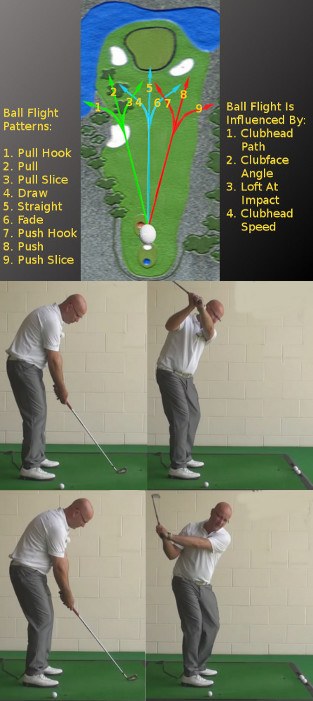
Two of the problem shots that golfers hit on the golf course are losing the ball to the left and right through a slice or a hook. Check out the ball flight of your shots to hit them straighter.
The flight of a golf ball can tell you a huge amount about what is happening in the golf swing. The following is not 100% correct in extreme cases, however it is a good rule of thumb for the average golfer. To correct wayward shots, find out what the club is doing through the ball by identifying two factors; the golf ball's initial direction – whether the ball flies to the right of, left of or straight at the target; the curvature of the golf ball in the air – whether the ball curves to the left, to the right or stays straight in the air.
For a right handed golfer the following applies, please reverse for left handed golfers:
As a rule of thumb, the club head sends the ball out on it's initial direction. This means that a club swinging across the ball from right to left or 'out to in' would make the ball start to the left of target. A club head swinging across the ball from left to right or 'in to out' would send the ball to the right of target. A club head moving straight through the golf ball towards the target sends the ball straight at the target.
The club face makes the ball curve in the air. A club face that is left or 'closed' in relation to the path of the club head through the ball makes the ball turn from right to left in the air, while a club face that is right or 'open' through the ball will make the ball turn from left to right in the air.
Having understood how the ball moves we can label these shots. A typical slice is a shot that begins left of the target but curves uncontrollably in the air to finish to the right of the target. This indicates that the club head travelled through the ball from right to left (the ball started to the left of target) with a club face that was pointing to the right at impact with the golf ball (the golf ball is curving to the right in the air). A hook is the opposite and begins to the right of the target and curves uncontrollably to finish to the left of the target. This indicates that the club head travelled left to right across the ball with the club face pointing to the left as it did so.
Once the shot and cause of it has been identified, use the following points to correct the accuracy of your shots:
If the ball is starting out a substantial amount to the left or right of target then straighten the club head path out to set the ball out straighter. Put a golf club on the floor next to the golf ball, pointing to the target. Hit some golf shots working to make sure that the golf club head is being swung down the line of this golf club. As a second check, look at the pattern of divots left by the golf shots to make sure that they match the line of the club on the floor.
If the ball is curving in the air too much, work on the rotation of the hands through the impact area. The hands control the golf club face and so rotating the hands earlier through the golf ball turns the club face to the left of the target which will reduce the curvature of a slice shot. Likewise, turning the club face later with the hands will hold the club face to the right of the target reducing the curvature of a hook shot.
Understanding ball flight and what it means can really help to make practice sessions much more productive and cure those hook and slice golf shots.






